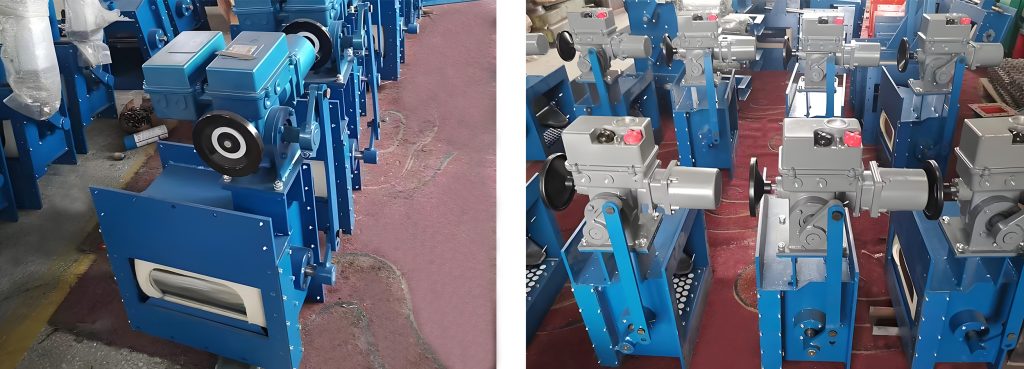In industrial operations where precision material handling and process control are critical, motorized flow control gates have emerged as indispensable tools. These automated systems enable precise, reliable regulation of bulk solids, powders, liquids, and granular materials—minimizing waste, enhancing safety, and optimizing throughput. From cement plants to food processing facilities, motorized gates provide a scalable solution for industries demanding accuracy and efficiency. This comprehensive guide explores their technology, applications, and transformative benefits in modern automation environments.
What is a Motorized Flow Control Gate?
A comporta de controlo de fluxo motorizada is an automated valve or gate system designed to regulate material flow using an electric, pneumatic, or hydraulic actuator. Unlike manual gates, these systems integrate motors to enable remote operation, precise positioning, and seamless integration with control systems like PLCs (Programmable Logic Controllers) or SCADA (Supervisory Control and Data Acquisition).
Core Components:
- Gate/Blade Assembly: A sliding, guillotine, or rotating mechanism (e.g., slide gate, knife gate, or butterfly valve) that physically controls material passage.
- Actuator: An electric motor (common for precision) or pneumatic/hydraulic cylinder providing the force to open/close the gate.
- Controller: Interfaces with sensors and plant automation systems to execute position commands.
- Feedback Sensors: Encoders or limit switches confirming gate position for closed-loop accuracy.
- Housing/Frame: Constructed from stainless steel, carbon steel, or wear-resistant alloys to withstand abrasion/corrosion.
Types of Motorized Gates:
- Slide Gates: Linear-motion blades ideal for high-pressure or abrasive applications (e.g., mining, cement).
- Knife Gates: Thin blades slicing through viscous materials (e.g., pulp, sludge, wastewater).
- Válvulas de borboleta: Rotating discs for low-pressure liquid or gas flow regulation.
- Diverter Gates: Route materials between multiple outlets (common in packaging or distribution).
How Do Motorized Flow Control Gates Work?
Motorized gates convert electrical or fluid energy into precise mechanical motion:
1. Command Initiation: An operator or PLC sends a signal to the controller (e.g., “Open to 50%”).
2. Actuator Engagement: The motor rotates, driving a gearbox or linear screw to move the gate blade.
3. Position Verification: Sensors relay real-time positioning data to the controller for accuracy.
4. Material Regulation: The gate’s opening modulates material flow into conveyors, mixers, reactors, or silos.
5. Safety Protocols: Emergency stop functions, torque limiters, and fail-safe modes (e.g., close on power loss) prevent jams or spills.
Automation integration allows these gates to respond dynamically to process variables like weight, pressure, or flow rate, enabling real-time optimization without manual intervention.
Key Applications Across Industries
1. Mining & Minerals
- Control ore/aggregate flow to crushers, screens, or loaders.
- Dust suppression via sealed housing designs.
2. Food & Beverage
- Sanitary stainless steel gates handle grains, powders, or liquids in FDA-compliant environments.
- Batch dosing for mixers and fillers.
3. Pharmaceuticals
- Precise ingredient dosing with GMP (Good Manufacturing Practice) validation.
- Containment for hazardous APIs (Active Pharmaceutical Ingredients).
4. Water/Wastewater Treatment
- Flow diversion in sludge handling or chemical dosing.
- Corrosion-resistant designs for harsh environments.
5. Power Generation
- Coal/biomass feeding to boilers.
- Ash removal systems.
6. Cement & Construction Materials
- High-wear slide gates for clinker, limestone, and gypsum.
5 Unmatched Benefits of Motorization
- Precision Flow Control: Achieve ±1% accuracy in material dosing for quality control and recipe consistency.
- Segurança reforçada: Eliminate manual handling in hazardous zones (e.g., high temperatures or toxic materials).
- Labor & Cost Savings: Reduce operator dependency and minimize spillage/waste.
- Process Integration: Synchronize with weigh scales, level sensors, and IoT platforms for Industry 4.0 workflows.
- Durabilidade: Engineered for 500,000+ cycles with minimal maintenance in extreme conditions.
Key Features to Consider When Selecting a Gate
- Compatibilidade de materiais:
- Abrasion-resistant liners (e.g., ceramic, urethane) for gritty materials.
- FDA-grade stainless steel for food/pharma.
- Actuator Type:
- Electric actuators for precision.
- Pneumatic for explosive environments (ATEX-certified).
- Sealing Integrity:
- Tight shut-off (ISO 5208 Class VI) for dust/pollutant containment.
- Control Interface:
- Modbus, Ethernet/IP, or 4-20mA signals for PLC compatibility.
- Accessibility:
- Quick-disconnect blades for cleaning or replacement.

Installation and Maintenance Best Practices
Instalação:
- Align gates perpendicular to material flow to avoid asymmetric wear.
- Ensure adequate support for heavy loads (e.g., hopper transitions).
- Verify electrical/pneumatic connections match plant standards.
Manutenção:
- Routine: Inspect seals, lubricate bearings, and test safety interlocks quarterly.
- Predictive: Monitor actuator torque trends via IIoT sensors to anticipate jams.
- Longevity: Replace wear components like seals or blades per OEM schedules.
The Future: Smart Gates and Industry 4.0
Motorized gates are evolving into intelligent endpoints:
– Otimização baseada em IA: Machine learning algorithms predict optimal gate positions based on historical data.
– Wireless Diagnostics: Bluetooth-enabled actuators relay performance metrics to maintenance teams.
– Sustainability Focus: Energy-efficient motors and lightweight composites reduce carbon footprints.
– Designs modulares: Plug-and-play components for rapid retrofitting.
Conclusion: Automating Efficiency
Motorized flow control gates represent a critical leap from manual intervention to precision automation. By enabling exact material regulation, enhancing safety protocols, and slashing operational costs, they underpin efficiency in sectors from pharmaceuticals to heavy industry. As plants embrace digitalization, motorized gates will increasingly serve as data-rich nodes in interconnected ecosystems—turning flow control into a strategic advantage. Investing in the right gate technology today isn’t just an operational upgrade; it’s a commitment to resilience, sustainability, and competitive excellence.

